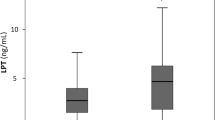Abstract
OBJECTIVE: The dimensions and maximum wall tension capacity of segments of human pial arteries from normotensive obese and non-obese patients were compared.
DESIGN: Segment size was assessed by quantitative morphometry of fixed sections and wall force by in vitro myography.
SUBJECTS: Twenty normotensive non-obese and 13 normotensive obese humans body mass index (BMI) 22.4±0.5 and 33.9±1.7 kg/m2, respectively) were studied.
RESULTS: There was no significant difference in the perimeter of the outer medial border, the smoothed out length of the internal elastic lamina, the ratios of media thickness to area and lumen diameter and the maximum wall force development between the two groups.
CONCLUSION: Obesity per se is not associated with initial dimensional changes nor capacity to develop wall tension that might lead to the emergence of hypertension.
This is a preview of subscription content, access via your institution
Access options
Subscribe to this journal
Receive 12 print issues and online access
$259.00 per year
only $21.58 per issue
Buy this article
- Purchase on Springer Link
- Instant access to full article PDF
Prices may be subject to local taxes which are calculated during checkout
Similar content being viewed by others
References
Dustan HP . Mechanisms of hypertension associated with obesity Ann Intern Med 1983 98: 860–864.
Hall JE . Symposium on pathophysiology of cardiorenal systems in obesity: a symposium in memory of A Clifford Barger Clin Exp Pharmac Physiol 1998 25: 57.
Muscelli E, Camastra S, Catalano C, Galvan AQ, Ciociaro D, Baldi S, Ferrannini E . Metabolic and cardiovascular assessment in moderate obesity: effect of weight loss J Clin Endocrinol Metab 1997 82: 2937–2943.
Su HY, Sheu WH, Chin HM, Jeng CY, Chen YD, Reaven GM . Effect of weight loss on blood pressure and insulin resistance in normotensive and hypertensive obese individuals Am J Hypertens 1995 8: 1067–1071.
Gros R, Borkowski KR, Feldman RD . Human insulin-mediated enhancement of vascular β-adrenergic responsiveness Hypertension 1994 23: 551–555.
Haynes WG, Morgan DA, Walsh SA, Sivitz WI, Mark AL . Cardiovascular consequences of obesity: role of leptin Clin Exp Pharmac Physiol 1998 25: 65–69.
Mangoni AA, Giannattasio C, Brunani A, Failla M, Colombo M, Bolla G, Cavagnini F, Grassi G, Mancia G . Radial artery compliance in young, obese, normotensive subjects Hypertension 1995 26: 984–988.
Vaz M, Jennings G, Turner A, Cox H, Lambert G, Esler M . Regional sympathetic nervous activity and oxygen consumption in obese normotensive human subjects Circulation 1997 96: 3423–3429.
Hall JH . Renal and cardiovascular mechanisms of hypertension in obesity Hypertension 1994 23: 381–394.
Mulvany MJ, Aalkjær C . Structure and function of small arteries Phys Rev 1990 70: 921–961.
Giannattasio C, Failla M, Mangoni AA, Scandola L, Fraschini N, Mancia G . Evaluation of arterial compliance in humans Clin Exp Hypertens 1996 18: 347–362.
Arcaro G, Zamboni M, Rossi L, Turcato E, Covi G, Armellini F, Bosello O, Lechi A . Body fat distribution predicts the degree of endothelial dysfunction in uncomplicated obesity Int J Obes Relat Metab Disord 1999 23: 936–942.
Bevan JA, Osher JV . A direct method for recording tension changes in the wall of small blood vessels in vitro Agents Actions 1972 2: 257–260.
Bevan JA, Dodge J, Walters CL, Wellman T, Bevan RD . As human pial arteries (internal diameter 200–1000 µm) get smaller, their wall thickness and capacity to develop tension relative to their diameter increase Life Sci 1999 65: 1153–1161.
Author information
Authors and Affiliations
Rights and permissions
About this article
Cite this article
Bevan, J., Dodge, J., Walters, C. et al. Dimensions and wall force development capacity of human pial arteries from normotensives is not altered in obesity. Int J Obes 25, 756–758 (2001). https://doi.org/10.1038/sj.ijo.0801600
Received:
Revised:
Accepted:
Published:
Issue Date:
DOI: https://doi.org/10.1038/sj.ijo.0801600
Keywords
This article is cited by
-
Is bulk flow plausible in perivascular, paravascular and paravenous channels?
Fluids and Barriers of the CNS (2018)



